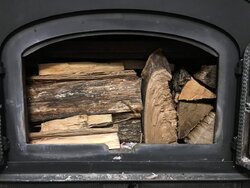Hi everyone, I was hoping to get some advice on my Quadrafire 7100. The insert is not especially deep, but is fairly wide. I think the manufacturer specifies 22 in as the max log length, but this is only going to be achieved by placing the logs in the insert length wise (my wood is too long to fit front to back). My understanding is that the air enters the fireplace between the doors just above the fire bricks. What I'm trying to figure out is how best to place logs such that it doesn't block the air coming in the center of the fireplace. I can understand how you would do it going front to back as you could just create a air channel between the logs. Placing lengthwise I haven't figured it out yet except to try and build up embers in the front of the fireplace and then put new logs on top of that. This next time my plan is to place logs diagonally from the front middle of the fireplace to the back corners, one going each way. (my logs are about 16'' max for front to back I think is around 14''). I would then stack logs on top of them. Has anyone ever done it this way and will it work or will the bottom logs be to far apart to be effective.
While i'm here talking about the 7100 does anyone have any suggestions for keeping the glass cleaner? The first few times I ran it, it got to the point that I could not see what was going on inside. I cleaned it and this last time it was a little better. Is keeping the fireplace hot the only thing I can do to alleviate this? The first times I ran it I tended to cut air flow down very low, which is what I was used to doing growing up. We would get it going and then pretty much cut all air and it would burn pretty hot, though i'm wondering now if there was just more leakage through the door than I am getting. Last time I purposefully gave more air when adding wood and never cut air all the way and this seemed to help keep it hotter and subsequently keep the glass a little cleaner. I'm guessing that part of my problem is my wood is not as dry as I would like. The provider said it was aged a year, but from what I can tell there is still quite a bit of moisture so I'm guessing it is old, but was not properly stacked for that time period. Unfortunately my options on this front are limited as I am reliant on a wood supplier. I do not live somewhere where I have my own supply of wood. My plan this year is to order wood at the end of winter and stack it all spring, summer, and fall to try and have it dryer for next winter. If anyone has any advice on keeping glass clean I would gladly take it as well. Thanks!
While i'm here talking about the 7100 does anyone have any suggestions for keeping the glass cleaner? The first few times I ran it, it got to the point that I could not see what was going on inside. I cleaned it and this last time it was a little better. Is keeping the fireplace hot the only thing I can do to alleviate this? The first times I ran it I tended to cut air flow down very low, which is what I was used to doing growing up. We would get it going and then pretty much cut all air and it would burn pretty hot, though i'm wondering now if there was just more leakage through the door than I am getting. Last time I purposefully gave more air when adding wood and never cut air all the way and this seemed to help keep it hotter and subsequently keep the glass a little cleaner. I'm guessing that part of my problem is my wood is not as dry as I would like. The provider said it was aged a year, but from what I can tell there is still quite a bit of moisture so I'm guessing it is old, but was not properly stacked for that time period. Unfortunately my options on this front are limited as I am reliant on a wood supplier. I do not live somewhere where I have my own supply of wood. My plan this year is to order wood at the end of winter and stack it all spring, summer, and fall to try and have it dryer for next winter. If anyone has any advice on keeping glass clean I would gladly take it as well. Thanks!


